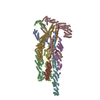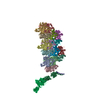[English] 日本語
 Yorodumi
Yorodumi- PDB-6vkl: Negative stain reconstruction of the yeast exocyst octameric complex. -
+ Open data
Open data
- Basic information
Basic information
| Entry | Database: PDB / ID: 6vkl | ||||||
|---|---|---|---|---|---|---|---|
| Title | Negative stain reconstruction of the yeast exocyst octameric complex. | ||||||
 Components Components | (Exocyst complex component ...) x 8 | ||||||
 Keywords Keywords | EXOCYTOSIS / EXOCYST / COILED-COIL | ||||||
| Function / homology |  Function and homology information Function and homology informationvesicle tethering involved in exocytosis / exocyst assembly / exocyst localization / negative regulation of SNARE complex assembly / endoplasmic reticulum inheritance / exocyst / prospore membrane / incipient cellular bud site / cellular bud tip / Golgi inheritance ...vesicle tethering involved in exocytosis / exocyst assembly / exocyst localization / negative regulation of SNARE complex assembly / endoplasmic reticulum inheritance / exocyst / prospore membrane / incipient cellular bud site / cellular bud tip / Golgi inheritance / cellular bud neck / Golgi to plasma membrane transport / mating projection tip / vesicle docking involved in exocytosis / spliceosomal complex assembly / exocytosis / transport vesicle / Rho protein signal transduction / phosphatidylinositol-4,5-bisphosphate binding / SNARE binding / cell periphery / intracellular protein transport / small GTPase binding / intracellular protein localization / protein transport / plasma membrane / cytoplasm Similarity search - Function | ||||||
| Biological species |  | ||||||
| Method | ELECTRON MICROSCOPY / single particle reconstruction / negative staining / Resolution: 15 Å | ||||||
 Authors Authors | Frost, A. / Munson, M. | ||||||
| Funding support |  United States, 1items United States, 1items
| ||||||
 Citation Citation |  Journal: J Cell Biol / Year: 2020 Journal: J Cell Biol / Year: 2020Title: Exocyst structural changes associated with activation of tethering downstream of Rho/Cdc42 GTPases. Authors: Guendalina Rossi / Dante Lepore / Lillian Kenner / Alexander B Czuchra / Melissa Plooster / Adam Frost / Mary Munson / Patrick Brennwald /  Abstract: The exocyst complex plays a critical role in determining both temporal and spatial dynamics of exocytic vesicle tethering and fusion with the plasma membrane. However, the mechanism by which the ...The exocyst complex plays a critical role in determining both temporal and spatial dynamics of exocytic vesicle tethering and fusion with the plasma membrane. However, the mechanism by which the exocyst functions and how it is regulated remain poorly understood. Here we describe a novel biochemical assay for the examination of exocyst function in vesicle tethering. Importantly, the assay is stimulated by gain-of-function mutations in the Exo70 component of the exocyst, selected for their ability to bypass Rho/Cdc42 activation in vivo. Single-particle electron microscopy and 3D reconstructions of negatively stained exocyst complexes reveal a structural change in the mutant exocyst that exposes a binding site for the v-SNARE. We demonstrate a v-SNARE requirement in our tethering assay and increased v-SNARE binding to exocyst gain-of-function complexes. Together, these data suggest an allosteric mechanism for activation involving a conformational change in one subunit of the complex, which is relayed through the complex to regulate its biochemical activity in vitro, as well as overall function in vivo. #1:  Journal: Nat Struct Mol Biol / Year: 2018 Journal: Nat Struct Mol Biol / Year: 2018Title: Cryo-EM structure of the exocyst complex. Authors: Kunrong Mei / Yan Li / Shaoxiao Wang / Guangcan Shao / Jia Wang / Yuehe Ding / Guangzuo Luo / Peng Yue / Jun-Jie Liu / Xinquan Wang / Meng-Qiu Dong / Hong-Wei Wang / Wei Guo /   Abstract: The exocyst is an evolutionarily conserved octameric protein complex that mediates the tethering of post-Golgi secretory vesicles to the plasma membrane during exocytosis and is implicated in many ...The exocyst is an evolutionarily conserved octameric protein complex that mediates the tethering of post-Golgi secretory vesicles to the plasma membrane during exocytosis and is implicated in many cellular processes such as cell polarization, cytokinesis, ciliogenesis and tumor invasion. Using cryo-EM and chemical cross-linking MS (CXMS), we solved the structure of the Saccharomyces cerevisiae exocyst complex at an average resolution of 4.4 Å. Our model revealed the architecture of the exocyst and led to the identification of the helical bundles that mediate the assembly of the complex at its core. Sequence analysis suggests that these regions are evolutionarily conserved across eukaryotic systems. Additional cell biological data suggest a mechanism for exocyst assembly that leads to vesicle tethering at the plasma membrane. #2: Journal: Nat Struct Mol Biol / Year: 2016 Title: Subunit connectivity, assembly determinants and architecture of the yeast exocyst complex. Authors: Margaret R Heider / Mingyu Gu / Caroline M Duffy / Anne M Mirza / Laura L Marcotte / Alexandra C Walls / Nicholas Farrall / Zhanna Hakhverdyan / Mark C Field / Michael P Rout / Adam Frost / Mary Munson /   Abstract: The exocyst is a hetero-octameric complex that has been proposed to serve as the tethering complex for exocytosis, although it remains poorly understood at the molecular level. Here, we purified ...The exocyst is a hetero-octameric complex that has been proposed to serve as the tethering complex for exocytosis, although it remains poorly understood at the molecular level. Here, we purified endogenous exocyst complexes from Saccharomyces cerevisiae and showed that they are stable and consist of all eight subunits with equal stoichiometry. Using a combination of biochemical and auxin induced-degradation experiments in yeast, we mapped the subunit connectivity, identified two stable four-subunit modules within the octamer and demonstrated that several known exocyst-binding partners are not necessary for exocyst assembly and stability. Furthermore, we visualized the structure of the yeast complex by using negative-stain electron microscopy; our results indicate that the exocyst exists predominantly as a stable, octameric complex with an elongated architecture that suggests that the subunits are contiguous helical bundles packed together into a bundle of long rods. | ||||||
| History |
|
- Structure visualization
Structure visualization
| Movie |
 Movie viewer Movie viewer |
|---|---|
| Structure viewer | Molecule:  Molmil Molmil Jmol/JSmol Jmol/JSmol |
- Downloads & links
Downloads & links
- Download
Download
| PDBx/mmCIF format |  6vkl.cif.gz 6vkl.cif.gz | 919.7 KB | Display |  PDBx/mmCIF format PDBx/mmCIF format |
|---|---|---|---|---|
| PDB format |  pdb6vkl.ent.gz pdb6vkl.ent.gz | 638.3 KB | Display |  PDB format PDB format |
| PDBx/mmJSON format |  6vkl.json.gz 6vkl.json.gz | Tree view |  PDBx/mmJSON format PDBx/mmJSON format | |
| Others |  Other downloads Other downloads |
-Validation report
| Summary document |  6vkl_validation.pdf.gz 6vkl_validation.pdf.gz | 751.4 KB | Display |  wwPDB validaton report wwPDB validaton report |
|---|---|---|---|---|
| Full document |  6vkl_full_validation.pdf.gz 6vkl_full_validation.pdf.gz | 835.2 KB | Display | |
| Data in XML |  6vkl_validation.xml.gz 6vkl_validation.xml.gz | 130.3 KB | Display | |
| Data in CIF |  6vkl_validation.cif.gz 6vkl_validation.cif.gz | 217 KB | Display | |
| Arichive directory |  https://data.pdbj.org/pub/pdb/validation_reports/vk/6vkl https://data.pdbj.org/pub/pdb/validation_reports/vk/6vkl ftp://data.pdbj.org/pub/pdb/validation_reports/vk/6vkl ftp://data.pdbj.org/pub/pdb/validation_reports/vk/6vkl | HTTPS FTP |
-Related structure data
| Related structure data |  21226MC M: map data used to model this data C: citing same article ( |
|---|---|
| Similar structure data |
- Links
Links
- Assembly
Assembly
| Deposited unit | 
|
|---|---|
| 1 |
|
- Components
Components
-Exocyst complex component ... , 8 types, 8 molecules ABCDEFGH
| #1: Protein | Mass: 154889.547 Da / Num. of mol.: 1 / Source method: isolated from a natural source Source: (natural)  Strain: ATCC 204508 / S288c / References: UniProt: P33332 |
|---|---|
| #2: Protein | Mass: 112236.875 Da / Num. of mol.: 1 / Source method: isolated from a natural source Source: (natural)  Strain: ATCC 204508 / S288c / References: UniProt: P89102 |
| #3: Protein | Mass: 93539.703 Da / Num. of mol.: 1 / Source method: isolated from a natural source Source: (natural)  Strain: ATCC 204508 / S288c / References: UniProt: P32844 |
| #4: Protein | Mass: 122367.109 Da / Num. of mol.: 1 / Source method: isolated from a natural source Source: (natural)  Strain: ATCC 204508 / S288c / References: UniProt: P32855 |
| #5: Protein | Mass: 100459.578 Da / Num. of mol.: 1 / Source method: isolated from a natural source Source: (natural)  Strain: ATCC 204508 / S288c / References: UniProt: Q06245 |
| #6: Protein | Mass: 105166.641 Da / Num. of mol.: 1 / Source method: isolated from a natural source Source: (natural)  Strain: ATCC 204508 / S288c / References: UniProt: P22224 |
| #7: Protein | Mass: 71382.328 Da / Num. of mol.: 1 / Source method: isolated from a natural source Source: (natural)  Strain: ATCC 204508 / S288c / References: UniProt: P19658 |
| #8: Protein | Mass: 85649.672 Da / Num. of mol.: 1 / Source method: isolated from a natural source Source: (natural)  Strain: ATCC 204508 / S288c / References: UniProt: P38261 |
-Experimental details
-Experiment
| Experiment | Method: ELECTRON MICROSCOPY |
|---|---|
| EM experiment | Aggregation state: PARTICLE / 3D reconstruction method: single particle reconstruction |
- Sample preparation
Sample preparation
| Component | Name: NEGATIVE STAIN MAP OF THE YEAST EXOCYST COMPLEX / Type: COMPLEX / Entity ID: all / Source: NATURAL |
|---|---|
| Molecular weight | Experimental value: NO |
| Source (natural) | Organism:  |
| Buffer solution | pH: 7.4 |
| Specimen | Conc.: 0.3 mg/ml / Embedding applied: NO / Shadowing applied: NO / Staining applied: YES / Vitrification applied: NO |
| EM staining | Type: NEGATIVE / Material: Uranyl Acetate |
| Specimen support | Details: unspecified |
- Electron microscopy imaging
Electron microscopy imaging
| Experimental equipment |  Model: Titan Krios / Image courtesy: FEI Company |
|---|---|
| Microscopy | Model: FEI TITAN KRIOS |
| Electron gun | Electron source:  FIELD EMISSION GUN / Accelerating voltage: 300 kV / Illumination mode: FLOOD BEAM FIELD EMISSION GUN / Accelerating voltage: 300 kV / Illumination mode: FLOOD BEAM |
| Electron lens | Mode: BRIGHT FIELD / Nominal magnification: 22500 X / Nominal defocus max: 3000 nm / Nominal defocus min: 2000 nm / Cs: 2.7 mm |
| Image recording | Electron dose: 50 e/Å2 / Film or detector model: GATAN K2 SUMMIT (4k x 4k) / Num. of real images: 6466 |
- Processing
Processing
| EM software | Name:  UCSF Chimera / Category: model fitting UCSF Chimera / Category: model fitting | ||||||||||||
|---|---|---|---|---|---|---|---|---|---|---|---|---|---|
| Image processing |
| ||||||||||||
| CTF correction |
| ||||||||||||
| Symmetry |
| ||||||||||||
| 3D reconstruction | Algorithm: FOURIER SPACE / Entry-ID: 6VKL / Num. of class averages: 1 / Num. of particles: 67509 / Resolution: 15 Å / Resolution method: FSC 0.5 CUT-OFF / Symmetry type: POINT
| ||||||||||||
| Atomic model building | Protocol: RIGID BODY FIT / Space: REAL | ||||||||||||
| Atomic model building | PDB-ID: 5YFP Accession code: 5YFP / Source name: PDB / Type: experimental model | ||||||||||||
| Refinement | Highest resolution: 15 Å |
 Movie
Movie Controller
Controller








 PDBj
PDBj

